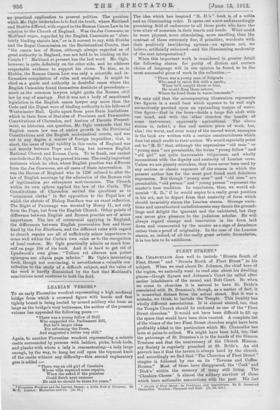LEARIAN VERSES.*
To an early Florentine woodcut representing a high medieval bridge from which a crowned figure with hands and feet tightly bound is being hurled by armed soldiery who loom as large as the bridge's very buttresses, the author of the present volume has appended the following poem :— " There was a young fellow of Brill Who supported the Parliament Bill, But he'd larger ideas For reforming the Peers,
And suggested a better way still."
Again, to another Florentine woodcut representing a minute castle surrounded by persons with ladders, picks, brick-hods, and planks with whom a lady is remonstrating—a lady large enough, by the way, to hang her coif upon the topmost knob of the castle without any difficulty—this second explanatory gem is added :— " There was an old girl of Carstairs Whose villa required some repairs, When she asked if the plumber Could finish next summer He said he should be there for years."
• Florentine Woodcuts and the Learian Stoma: a Little Book of Nonsense. By D. London ; Macmillan and Co. [Su ad.]
The idea which has inspired "R. D.'s " book is of a noble and an illuminating order. It opens out a new and exceedingly:
promising field of endeavour to all those poets who have the, true elixir of nonsense in their hearts and heads. What could.
be more piquant, more stimulating, more startling, than the contrast of these extremely fine, if primitive, woodcuts with. their positively bewildering aptness—an aptness not, we believe, artificially enhanced—and the illuminating modernity of the text interpretation?
When this important work is considered in greater detail the following stanza for purity of diction and correct choice of language will in our opinion be found to be the most successful piece of work in the collection :—
" There was a young man of Belgrade Who used to catch fish with a spade;
When he'd caught three or four, He would fling them ashore,
Where he fried them in warm lemonade."
We may add that the accompanying illustration represent!. two figures in a small boat which appears to be well nigh
miraculously perched upon an upstanding tongue of water: One figure—that in the bows—holds a large fish aloft witlr one hand, and with the other clutches the handle off some instrument, apparently agricultural. The above- stanza is, indee I, a fine and mature piece of work, but,
alas ! the worst, and even many of the second worst, examples• in the book are written with a certain amateurishness which. does but small credit to their author. We would especially point out to " R. D." that, although the expressions " old man " or " young man " are permissible, the terms "young fellow " and "old girl" are quite inexcusable vulgarisms, and wholly inconsistent with the dignity and austerity of Learian verse. Unless we are greatly mistaken, they have never been used by any serious or classic exponent of the stanza in which the present author has for the most part found such felicitous expression. But though "young man" and "old man" are
permissible, " old person " and " young person " represent the master's best tradition. In conclusion, then, we would ad- monish "R. D.," if he would aspire to a really great position in his art, not to depart from that austerity of form which should invariably stamp the Learian stanza. Strange varia- tions and unauthorized embellishments may dazzle the ground- hinge and delight the ignorant and the unlettered, but they can never give pleasure to the judicious scholar. He will always regard change and innovation in the form laid down and consecrated by the master as a sign of decadence
rather than a proof of originality. In the case of the Learian stanza, as, indeed, of all the really great artiatio formularies, it is too late to be ambitious.










































 Previous page
Previous page